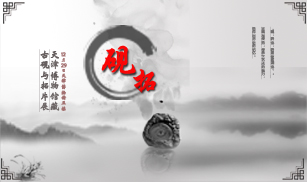展期:2015年12月29日~
地点:五楼
票务信息:本厅凭博物馆门票入场

展期:2015年12月29日~
地点:五楼
票务信息:本厅凭博物馆门票入场
砚台是中国古代用来研墨的文房用具,与笔、墨、纸并称为“文房四宝”。一方匠心独具的砚台往往蕴含了雕刻、绘画、书法、历史、文学等丰富的内容,于精雕细琢之下充分抒发了文人雅士的情怀和意趣。传拓是中国传统手工技艺之一,一幅精心制作的砚拓不仅能够真实、全面地反映砚台原貌,而且将砚上文字与图案的粗细、深浅等细微特征形象地表现出来,黑白分明,使人一目了然。
此次砚、拓合一展出,在天津博物馆尚属首次。天津博物馆藏古砚主要来自天津著名古文物收藏家徐世章(1889~1954)先生旧藏。展出的古砚造型典雅,雕刻隽美。徐世章先生不仅潜心搜集资料,整理研究,而且注重装潢保护,每一方砚台都要传拓留影。展出的砚拓均为民国时期的原拓,纹饰清晰,层次分明,出自著名篆刻、传拓专家周希丁(1891-1961)先生之手。砚、拓互相映衬,每方佳砚的灵动风姿得以通过不同地表现形式呈现在观众面前,别具一番韵味。希望能够在砚、拓之间与您共同领略中国古砚丰富的文化内涵。
Selected Ancient Inkstones and Rubbings Collected by Tianjin Museum
(砚拓——天津博物馆藏古砚与拓片展)
Inkstone has been being used in study for grinding and concocting ink since the ancient times in China, and collectively known as the “scholar’s four jewels” with writing brush, inkstick and paper. An inkstone showing originality often features the combined techniques of engraving, painting, calligraphy and rich contents of history and literature, fully expressing the scholars’ thoughts, feelings and taste. Making rubbing is one of the traditional Chinese craftsmanship. An elaborate inkstone-rubbing could truthfully and clearly display not only the full original surface of the inkstone, but also the details of the characters and patterns on the one with design.
This is the first time for Tianjin Museum to put inkstones and their rubbings together on display. The delicate inkstones and the original rubbings made during the period of Republic of China well set off each other, thus present the more complex charm of the ancient inkstones as well as their cultural connotations to the visitors.